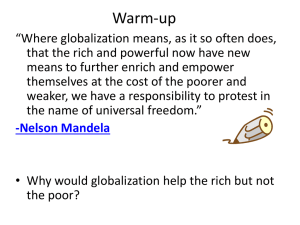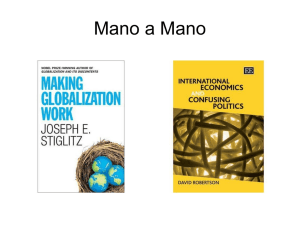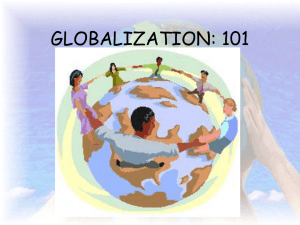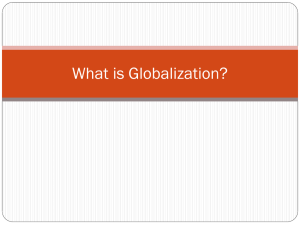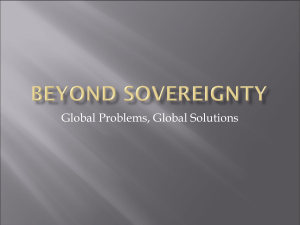- Economics by Dr. Shradha
advertisement
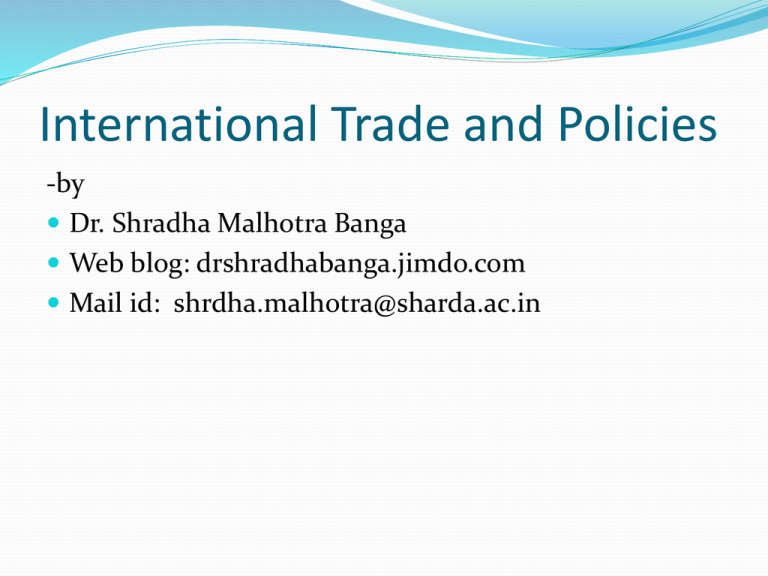
International Trade and Policies -by Dr. Shradha Malhotra Banga Web blog: drshradhabanga.jimdo.com Mail id: shrdha.malhotra@sharda.ac.in About the Instructor Shradha M Banga Academic Qualification Ph.D.: Rajasthan University, Jaipur M.B.A. (Investments) : ICFAI University M.A. Economics: Rani Durgawati University, Jabalpur Mastery in : Innovation and Commercialization: Massachusetts Institute of Technology, Cambridge, U.S. Globalization: University of Georgetown, U.S. Statistics Inference: University of California, Berkeley, U.S. About the Course 6 units covering: Introduction of international trade, theories, trade trends, policies, organizations and impact on economy glbn.flv Objective of Session To define globalization and international business and show how they affect each other To discuss the major advantages and disadvantages of globalization To understand why companies engage in international business The Globe Continents: Asia, Africa, N America, S America, Europe, Oceania, Antartica..en_continents.gif Continents are landmasses divided by oceans.. Oceans.. Pacific, Atlantic, Indian, Southern (Antarctic), and Arctic Oceans..world-oceans-map.jpg Globalization Definition: ‘emergence of interdependent relationships among people from different parts of a world’ Set of relationships Between different nations Globalization related relations… Aid to a poor country Fashion show paegent Football match Leisure trip How Globalized are you Globalization_ You're living IT_(360p).flv Global brands in India Globalization: Indian brands in global business Factors contributing to Globalization Increased used of technology Liberalization of cross-border trade and resource movements Development of services that support international business Growing consumer pressures Increased global competition Changing political situations Expanded cross-national cooperation The Criticisms of Globalization Threats to national sovereignty Growth and environmental stress Growing income inequality Pros and Cons of Globalization_(360p).flv Advantages Access to multiple markets Collaborative decision making Cultural awareness Swift spread of information Tolerance upgradation Disadvantages of Globalization Inequality of income Americanization Socially unequal distribution of world resources Commodification of labor Less accountability for rich countries in name of development Spread of deadly diseases Inhumane use of PoW and child labor Human trafficking Definition of International Business All commercial transactions—including sales, investments, and transportation—that take place between two or more countries Reasons That Firms Engage in International Business Expanding sales Acquiring resources Minimizing risk Modes of Operation in International Business Merchandise exports and imports Service exports and imports Tourism and Transportation Service Performance: banking, insurance, engineering, management, interest and dividend Asset Use Investments: FDI(controlling interest) and FII(non controlling interest) Types of International Organizations Collaborative arrangements Strategic Alliance Multinational Enterprise (MNE) Collaborative Arrangements Used to define: Companies that work as joint ventures, licensing agreements, management contracts, minority ownership and long term contractual arrangements New alliance Strategic Alliance Same as collaborative agreement but often reserved to refer either to an agreement important to one partner Or an agreement that does not involve joint ownership Joint work but identity apart Multinational Enterprise (MNE) It takes a world wide view.. And is willing to consider market and production locations anywhere in the world.


